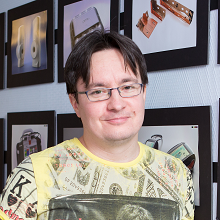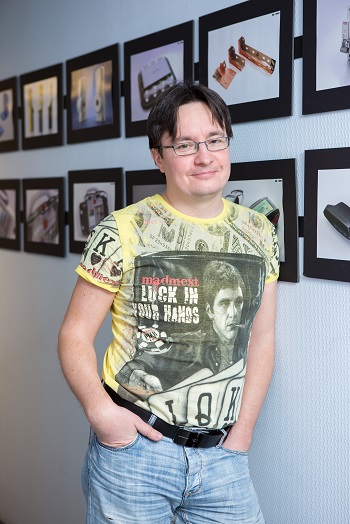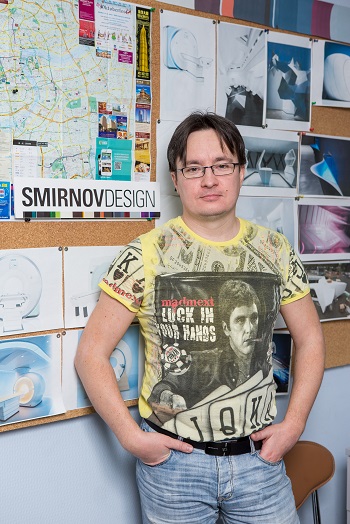
Let’s talk about industrial design. What stands for this term in Russia? Who creates industrial design today? And what does 3D printing have to do with it? No one can tell better about it than someone who worked at ground zero of developing it in our country. The maître of industrial design Sergey Smirnov, the president of Smirnov Product Development Group, shared with us his point of view upon it.
Introducing yellow photopolymer – our new material for 3D printing for jewelry
From the history of industrial design in Russia
- Your first commercial project in industrial design is dated 1994, when you developed series of switches and sockets for Elektrotechnika IGO. 20 years have already passed. What has changed since then in the approach to industrial design in Russia?
If we are talking about the epochs, then the substantial difference between modern industrial design in Russia and design in Soviet times is in projection systems.
When I was a beginner in 1994 the Soviet epoch still lasted. Then the computer projection systems weren’t developed enough. Everything was handmade. In 1994 I made the switches manually without a computer. The computers were not powerful and the programs were prohibitive for small companies and freelancers, and I was a freelancer at that time.
In 1995 I left for the army for 2 years and when I returned to civilian life, the computers had become more moderate. In 1997 I had a computer. I learned three-dimensional graphics very quickly and I even started to teach it after some months. By 1998 I already started thinking of establishing a company, so I started looking for a partner. So that time SmirnovDesign was conceived.
- How did the perception and the conduct of consumers, the consumers of all the industrial design change?
After the epoch of deficit, the consumers were picking up all and sundry. The people were looking at everything greedily enough. Then design imitated foreign things. The consumer was beauty-hungry, he took everything he was given. Now he is more spoilt, more globalized.
But today the consumer decides even less what he wants. They rather decide for him. And it’s quite another matter, that great companies are trying to please the consumer so much that we have a vicious circle as a result.
Big corporations study the consumer in details, and all of their aspirations are intended to make things better for the consumer. Sometimes a company considers that it would be better for the consumer this way, and then just lays down the law to him or her and says “That’s it”. And the consumer is happy. He or she believes that it would be better for him or her. For example, Apple production was generated exactly this way. These are really good things. But one isn’t given a choice.

- Who sets world trends today and do they exist in industrial design? Which of the counties is a leader?
The USA and Europe of course. There are centers of development. They set the trends. Though China starts to approve itself idependantly. This is not a trend but the rise of a trend. China is going to make its own interesting products. It can be seen on exhibitions in China. They were copying very actively for the last 10-15 years and they continue copying actively but they have a huge army of industrial designers who were taught in Europe. Now the flow of them is happening back to China. And these young Chinese designers start creating their interesting things. I think that in the future we will feel it more and more.
- Does China have the potential to change the paradigm in which America is dictating its terms?
Yes, in about 20 years Chinese youngsters grown up in European conditions and taught by Europeans will do that. They will be mature independent personalities and we will see good design products from China.
- How do you think if there’s a country which has such an experience in industrial design that Russia can take its lead from? And is there a sense to take lead from somebody?
The question is quite philosophical. There’s no simple answer for that question. Certainly, I would recommend us to learn from Europeans, Americans and Chinese. Learn to copy. The Chinese have learned that but we can’t do even this. Undoubtedly, we have personnel potential. Our country will give birth to talents. This is it and it will be there. No crises will drain it.
That’s why we should take our lead from the youngsters. Think about why is our personnel so valuable abroad? Our guys are trained here and then leave. I mean talented guys, they are valued. If we somehow globally could rely on these frames, we might create even our system, our school.
- Is it connected primarily with the fact that the concept of industrial design, even in the minds of ordinary citizens, is difficult to separate from the general concept of "design" in Russian?
The word "design" should be banned, I’d say. And all will fall into place. If I'm going to explain you what I do without using that word, it will be much more clear to you than just saying "industrial design."
- What word can be used instead of word "design"?
I'm creating a new product. I develop aesthetics, ergonomics, design, efficiency, cost of new products. "Creating a new product" sounds better than "design". Because what kind of a designer I am? - Probably, I design apartments’ interior. Something like this.
Now design in Russia is more decorative and applied arts, graphic design and interior design, than industrial design. This is the peculiarity of Russian language, to be precise of the term in the Russian language.
- How do you think industrial design will be developing the next 10-20 years in the world in general, and in Russia in particular? Do you have any forecast?
Russia is highly dependent on macroeconomic development. Generally, industrial design is a kind of litmus paper of industry. Industrial design is called industrial because it is a certain element of competition among industrial enterprises. If the industry is going to develop, then industrial design will develop as well.
- And will we see young industrial designers and good design solutions from Russia?
If there is no industrial development, we won’t. The chance that we will play a role that is prominent on the world market is minimal.
About the peculiarities of working with Russian customers
- Recently you’ve often talked about such an important area of work in the industrial design as a design research. How is the situation today with the customers’ perception of design research?
We are one of the leaders in the field of design research. We are actively promoting this story, we are the drivers of it. Although little is taught in this subject, it is more practice. Almost every project we try to view through the prism of design research in varying degrees.

Design researches are the most important procedure that can be described as: "Measure twice and cut once." Clients come to us and say, 'On, cut. " And we say, "Wait, stop. Let us try. Cutting is easy - we can make sketches quickly. But are you sure this very designer knows and understands your equipment? In your medical device, which is used by certain professionals? Let’s find it out. Let's try. "
Sometimes we have to ask: "Are you sure yourself that you’re informed about your product so well? You are not a key user of your product. You are an engineer or a businessman." It sounds reasonable. When we explain that way people do understand.
- And customers do agree with that?
More and more customers agree with us. Firstly, there are people who tried to disagree 5 years ago, and they come back to us after several years of knocking about and losing a lot of money. The problem is that it is a resource-intensive task, it requires a lot of human resources, and for a customer this transforms into financial resources. The cost of the project can grow 5 times.
Secondly, when we say that it is only half a percent of the cost of the product, the customer is somehow easier to make a choice. To pay one-tenth of the value of the product and take a risk or to pay half a percent and take no risk. When reasoning this, then you understand all.
- What do you think influenced the fact that today customers began to admit the need for design research? Today the word "design research" is often heard.
Today there is the culture of business planning for new projects. A businessman is changing who 10 years ago wanted to make a beautiful thing just on a whim, because he saw something special in the window in England. And it occurred to him that he has to do it here too. Now after toils and torment he begins to take a mature approach to business planning. He understands that there are risks, and thinks how to minimize them. Today there are people who make a sober estimate of the entire project, all the risks and investments.
About the experience of the application and the use of 3D printing
- When did you first encounter with the use of technology in the activity of three-dimensional printing? What was this project?
It was a very long time ago, because 3D printing technologies have been around for many years. Our first prototypes were made by curing photopolymer with laser. Stereolithography. Before that there was LOM technology of 3D printing with paper. This is when there are layers cut of paper. Excellent technology. I do not know why it has not caught on.
In fact, 3D printing has a great future of course. It is definitely, but now it is popularized too much and overrated in my opinion. Although soon any project won’t do without 3D printing - this is obvious.
My first project. I think this was 1999. Maybe some small handle for a jucuzzi. When it was necessary to check it and we printed a prototype.

- What are the prospects for the development of 3D printing?
3D printing is an indispensable tool of industrial design for any project. Just there is a feeling that if you bought the machine for 3D printing, you can already do nothing further, you already have industrial design. I exaggerate a little, of course.
All the same, it is a tool. They need to be able to use it. I know that the 3D printing process is pretty complicated. A lot of clumsy prototypes we have received. Instead of a functional prototype will be a clumsy thing, which would be very difficult to assemble. But to clean it, to treat, to paint, to apply graphics – these cannot be done with the help of the machine. It is necessary to ensure the quality of post-processing. This is my deeper understanding of things.
Therefore we do a lot of prototypes by milling on CNC machines. They have good quality. But the printing is also improving. Now there are 3D printers of a very high accuracy. We did the latest prototypes with the use of equipment of very high level of accuracy. In microns. And indeed, very high quality item. Not cheap, but very quickly and accurately made.
- Now there has been more talk about the point that in the near future 3D printing may replace, or at least put significant pressure on modern forms of production. This will fundamentally change the consumer model and the entire market. In your opinion, whether such statements are justified, and what niche will this technology take as a result?
I think it will happen. I'm not sure I can say that 3D printing will supplant something. Most likely, it will be converted and integrated into the everyday world. Here, did printers replace the newspapers? – No, they didn’t. The printer makes its task. Every family now has a printer.
The same thing is with 3D printers. It is possible that some household utensils we will print with ease, because everything will be adapted to it. Printers will be sufficiently accurate, but I do not think that a home printer will print a knife easily.
But the solution will be. Be sure every family will have a 3D printer.
- Will there be some kind of niche, where 3D printers will be especially in demand?
In engineering they will be needed everywhere. It makes no doubt. Tomorrow is with 3D printers. You can just download and print a 3D model. Some accessories. Some things that do not require electronics. Which does not require special technology or complex metals.
For example, a glass. Let's say I have guests to come today. It is not cool for me to put on the table the same glasses which were last time. I made a 3D model of a new glass and printed it. Then I threw them into a special trash. I mean it's all going to cost a penny, at a cost of ABS.
Now, if we take a 3D printer to print FDM (most developing printing), it is affordable and cheap. FDM printing is clumsy generally. Terrible thing. But it will find its use. For example, it is necessary to try a handle for some tool. Where the item is massive and full. There, this type of printing is suitable.
- Did you have a need to use three-dimensional scanning in your work? How much this service is on demand today?
At industrial design it is rarely claimed, if not talking about reverse engineering, when we have something to copy. Because we are creating a new one. Where scanning can be used? - When you need to match some intricate details. For example, there is a motor, it is necessary to make a shell for it. In order not to build up it for a long time, it can be scanned.
About the view upon education of the rising generation
- Your father is an artist and a jeweler. You grew up in a creative, inventive environment. Surely, this influenced your career choice. What can you say about your children? In today's information age, whether they are interested in your work, in modern technologies, and 3D printing?
There is one very interesting thing. Naturally, the children are now well in the uptake of Ipads and computers, but they do not know how to break a stick, how a match is burning. I exaggerate, but they are far from it. Computers in fact play a negative role in it. Children stopped to get involved in some needlework, some tinkering. I notice it in my children too, unfortunately.
Whether they are interested or not? Now they both are schoolboys. They are happy when they notice things created by me. But I do not try to impose anything. I do not want to impose, because I still do not really understand what their vocations are.
They are like any kids. All children are exactly the same – they try, they are interested in, and then they get bored.
- What skills and knowledge a good industrial designer should have today?
When people ask me what industrial design is, and who is an industrial designer, my wording is as follows: "an industrial designer is a cross-sectoral integrator in the development of new products, where, of course, aesthetics, ergonomics and efficiency of consumption of this product play a crucial role".
The key word here is interdisciplinary integrator. What is it? This is a person who should have the knowledge about consumer and the creation of the product life cycle.
He has to be able in part to make calculations and be a kind of economist. He should be a marketer because he has to understand the consumer. He should be a futurist and a man who looks into the future and can assume some things. He must have good taste and good aesthetic development of his own vision. The ability to draw and convey his thoughts at least visually. Must possess a three-dimensional thinking. He must be an engineer; otherwise, he will draw a crap, which the engineer will then sort out. He has to be able to communicate. He has to be a material engineer. Should understand modern materials, conventional materials. Generally, all. All that he needs to know.
I'm talking of course about good designers. All this knowledge, he should have not at 100% and not at 10%, but in the future he should be able to explain and to perceive information from experts.
Multidisciplinary approach, otherwise no successful product.
 |
 |
 |
- Don’t you think that it is very difficult? Many designers occupy certain product niche. Perhaps this is correct, isn’t it?
Quite right. To be such an all-round man is very difficult. Such Lomonosovs are few. And I'm not like that. I have my own strengths too, weaknesses, and this way people are determined and become somewhere more effective. Someone realizes his or her potential in furniture. Someone is more of an artist, and he has less technologically-constructive knowledge. And he is looking for a partner or production.
Our company also has two kinds of designers. I even register such units. There are designers, and there are designers-analysts. There are guys who are more inclined to be stylists, and there are guys who are more prone to system analysis and target setting.
But I in fact "force" everybody to engage in researches. All-round development is very important. That’s why it is useful for all to do different things in projects, and it's very interesting.
- What needs to be changed in the approach to education, in order to increase the number of professional industrial designers, 3D modelers and experts in the three-dimensional prototyping? What should be changed in order to the state acquire an interest to this topic?
That is a difficult question. The state has a formal interest in this, but it's so much formalized. Only practical men, experts can teach well. And good training can only be in practice. All other theoretical knowledge, they are also necessary, and the institution gives them, but the teacher has to be a practitioner, and this is now a problem. Because overall we have few practitioners. And, indeed, SmirnovDesign is a such design school de facto in Russia, because a lot of guys leave us, and I'm proud of it, and they established their own companies. These are Art-up and Designworks. And a lot of other companies.
All who have been here, and all who remained in the industry, are a piece of SmirnovDesign and they distribute it. This is one of SmirnovDesign’s missions.
But I do not aspire to education. But as it turns out, that willy-nilly when you set young man on a real project, you teach him and tell things.
- What needs to be done to ensure that in Russia, and all over the world, an interest for industrial design and for its’ promising tools such as 3D printing would develop?
I do not think that the situation will change globally. It is necessary to develop the demand. Demand creates supply. A simple formula. Accordingly, if the Russian government and the state will be able to develop a demand for industrial design, then industrial design will develop too. This in turn creates a demand for students. Which in turn will make a supply for education. All follows the string.
- What kind of professional advice you can give to those people who want to engage in industrial design in our country?
Practice industrial design, in spite of everything. Love this occupation. Make projects, look for these projects, find these projects, develop on one’s own, just lovingly move in this direction. This is the only one. All the rest will come.
Author: Daria Kazovskaya
Photo: Maria Andreeva
website SMIRNOVDESIGN: www.smirnovdesign.com
“3D printing technologies have good future, not to mention good present already” - Catherine Kopytina about her experience with 3D printing in industrial design
